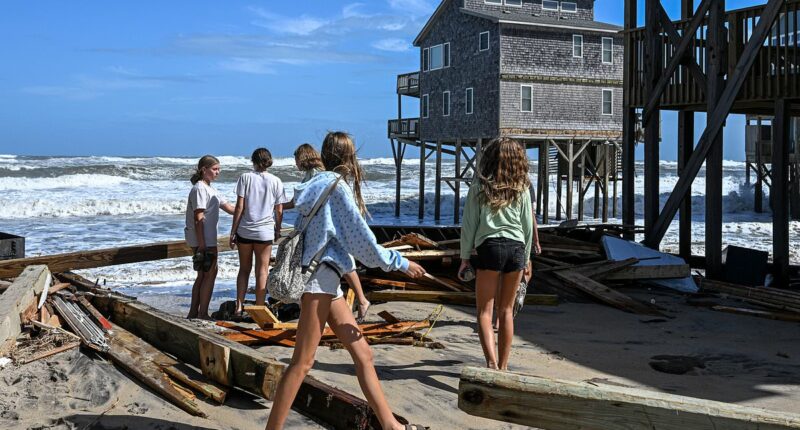Share this @internewscast.com
This week, five oceanfront homes in Buxton, North Carolina, succumbed to the relentless Atlantic Ocean, adding to a troubling total of 15 homes lost to the sea this month alone.
Faced with the impending threat, one family realized their home was next in line for destruction.
As powerful 10-foot waves pummeled the wooden supports of their house, they turned to Barry Crum, the only local equipped and willing to challenge the ocean’s might.
Crum and his crew specialize in literally lifting endangered homes and relocating them further inland, sometimes as far as 150 feet, offering homeowners a potential reprieve of five to ten years.
In an interview with the Daily Mail, Crum explained that while outsiders might call his work ‘crazy,’ he has successfully relocated about 24 homes to the remaining safe spots available. Homeowners with larger plots and better road access away from the shore have a greater chance of preserving their residences.
However, many property owners choose to let their homes be claimed by the sea. With a hefty price tag of $350,000 to move a home and the accompanying stress, some have decided to accept the ocean’s encroachment as a foregone conclusion after years of watching it inch closer.
Letting the houses fall means they can collect an insurance payout, though it’s rarely more than $250,000, often barely half of what they originally paid.
This week, his crew pulled off another dramatic coastal rescue, hoisting a large home on Old Lighthouse Road back from the edge just as the waves began smashing through its pilings.

Condemned homes in Buxton, NC. Many choose to let the homes surrender to the sea, because moving them can be upwards of $350,000

Crum Works Inc. has the equipment to literally pick up an at-risk house and move it further away from the shore in hopes of buying it five to ten more years
The house, built in 1980 when dunes and vegetation still shielded it from the sea, had long since become oceanfront as erosion ripped away the beach.
‘We were getting 10-foot waves every few days,’ Crum said.
Crum grew up in the Outer Banks and already had much of the heavy equipment he needed from years of clearing debris after storms and laying sandbags.
Eventually, he realized he could use it to tackle a problem the town had talked about for years: saving homes by literally moving them.
For the families who hire him, it’s not just about protecting property — it’s about holding onto a way of life that’s disappearing as fast as the shoreline.
‘It’s not a permanent fix,’ Crum admitted. ‘But if we can buy them five or ten more years, that’s worth it.’
The operation began on October 15 when Crum’s crew dismantled the deck, slipped steel beams beneath the house, and used a jacking system to raise it off its failing pilings.
The structure was then loaded onto wheel dollies and carefully rolled 60 feet inland — the first marker beyond the immediate danger zone.

One of the last remaining homes on a stretch of beach in Buxton, NC, where 15 houses have fell into the sea in just a few weeks

The coastal haven is fragile because of its geography and small size, and because it lacks protection from the ocean, such as sea walls, which Buxton may build in coming years

With standard FEMA flood insurance, a homeowner is only gonna get about $250,000 if their home falls in the ocean

Crum Works construction workers moving a home 60 feet back from the ocean in Buxton, NC, where homes have been falling into the Atlantic
A final survey in the coming weeks will determine whether it can be moved another 90 feet toward the road.
‘With this house in particular, first I look for a good weather window,’ Crum said.
‘I’ll get everything ready. We use structural beams and we build a trailer under the house.’
Custom-built hydraulic jacks then raise the home — sometimes more than 20 feet into the air.
‘We build the jacks ourselves. I’ve lifted houses 21 or 22 feet high,’ he said.
Once it’s off the pilings, the excavator pulls it away from the surf while new supports are installed.
Carpentry crews notch and lower the structure onto its new foundation — all measured with precision. It’s all measured with a large level.
‘Yesterday they actually cut notches in the pilings, so you know how the house is going to stay and have a longer life,’ he said.

Barry Crum and Crum Works Inc. specialize in picking up houses in Buxton, NC, and moving them further away from the shore. Homeowners pay upwards of $300,000 to hire him

Barry Crum owns the equipment that can safely move a house away from the shore in Buxton NC, where 15 homes have fallen into the sea in weeks

Others choose to let the homes fall and collect the FEMA insurance, which caps out at $250,000 usually around half of what the owner paid for the house
Why not just let it fall?
If the sea is coming for it anyway, why bother?
The reason is part financial, part sentimental.
‘It kind of makes financial sense most of the time,’ Crum said.
‘Your standard FEMA flood insurance, you’re only gonna get about $250,000.
‘It’s expensive to move a house, but it’s not nearly as expensive as building a new one. And you can’t rebuild right on the oceanfront anymore.
‘Plus, if you move the house you can get back in it a lot faster than if you build one, but you can’t even build one in these areas anyway anymore.
‘You have to use these houses that are there or lose them.’

Buxton residents inspect the debris the fallen homes have left. Owners have to pay for their own debris cleanup and many don’t leaving to Barry Crum to come in and do it

Locals check out which houses are still standing and which have been sucked away by the Atlantic following a series of rough storms

Many of the homes were second holiday homes, but many are also full-time residences leaving locals devastated by the state of things
Many of those affected are not wealthy investors, Crum said, but longtime residents with deep roots in the area.
‘There is some sentiment,’ he said.
‘But most of the time it makes financial sense. A lot of people have worked their whole lives for their dream home and these places are full of memories.’
The future of Buxton
Crum said the local community is devastated as they watch their homes and neighbors homes eaten by the sea.
And each loss has a ripple effect throughout the small local economy.
‘Think about it,’ Crum said. ‘Fifteen houses means fifteen families and their friends every week in the summer.
‘There’s the housecleaners, restaurants, fishing shops, grocery stores, it all adds up.

Lori Perkins called the four-bedroom beach home she owns in North Carolina ‘s Outer Banks ‘a dream come true for her and her family and would often lend it to friends for free

One of the last remaining homes did fall into the ocean this week. It was owned by a woman who lived there up until August

Crumb Works Inc. works with local government to determine a safe time to go in and do debris cleanup or move a home
‘When those houses fall, the whole community feels it.’
He’s seen people checking out the ocean debris in tears.
‘A lot of us take it personally, he said. ‘It’s depressing.
‘Even if it’s not your house, you’ve been working on these homes for years. We know the owners. We feel it too.’
How it started
Crum grew up in the heavy-equipment world, with his father running a similar business where he’d tag along as a kid.
He got hooked after witnessing his father help move a famous local lighthouse in the late 1990s.
‘It was just fascinating to me that you could do that,’ he said.

Debris left over from a home that fell into the ocean. Owners have to pay for their own clean up and some just never return to the area

The shoreline creeps closer and closer to Buxton homes, some which probably can’t withstand even more more storm before they topple
Years later, he was literally handed a house that was in danger from an owner who didn’t want to deal with it anymore. There was one catch.
‘My first house was actually given to me,’ he said.
‘I just had to move it. I put the equipment together and moved it myself. That’s where I live now.’
Today, Crum Works Inc. has become the go-to name in Hatteras for saving homes on the brink of disaster.
‘I get by from word of mouth, it’s such a unique job and people just call me to do it,’ Crum said.
The cost
Moving a house is costly, with expenses depending on size, distance, permits, and rebuilding septic systems, Crum said.
In total, costs can get as high as $400,000, depending on the size of the home, how much it will take to move it, and disconnecting and reconnecting the sewer and electric.
Homeowners pay entirely out of pocket. But for many, it’s worth it.
‘It’s not just a structure, it’s someone’s life, their memories. You save that, and it feels pretty good.’

















